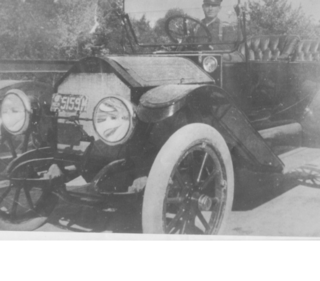
An antique car is an automobile that is an antique. Narrower definitions vary based on how old a car must be to qualify. The Antique Automobile Club of America defines an antique car as over 25 years of age. However, the legal definitions for the purpose of antique vehicle registration vary widely. The antique car era includes the Veteran era, the Brass era, and the Vintage era, which range from the beginning of the automobile up to the 1930s. Later cars are often described as classic cars. In original or originally restored condition antiques are very valuable and are usually either protected and stored or exhibited in car shows but are very rarely driven.
The Adams Company is an American manufacturing concern. It was founded in 1883 and is based in Dubuque, Iowa, United States.

The Brass Era is an American term for the early period of automotive manufacturing, named for the prominent brass fittings used during this time for such features as lights and radiators. It is generally considered to encompass 1896 through 1915, a time when cars were often referred to as horseless carriages.

The Alpena Flyer was an American automobile manufactured between 1910 and 1914 in Alpena, Michigan by the Alpena Motor Car Company. Approximately 480 cars in 13 models were produced, costing around $1,500, and only one remaining car is known to exist today. The car was intended to be light and inexpensive, and to make Alpena into an "Automobile City".
Northern Manufacturing Company was a manufacturer of Brass Era automobiles in Detroit, Michigan, automobiles designed by Charles Brady King. Early advertising included catchy phrases such as "Utility is the Basis for Beauty" and "Built for Business" and the famous "Silent Northern".

Crude ideas and designs of automobiles can be traced back to ancient and medieval times. In 1649, Hans Hautsch of Nuremberg built a clockwork-driven carriage. In 1672, a small-scale steam-powered vehicle was created; the first steam-powered automobile capable of human transportation was built by Nicolas-Joseph Cugnot in 1769. Inventors began to branch out at the start of the 19th century, creating the de Rivaz engine, one of the first internal combustion engines, and an early electric motor. Samuel Brown later tested the first industrially applied internal combustion engine in 1826. Only two of these were made.

The Lozier Motor Company was a brass era producer of luxury automobiles in the United States. The company produced automobiles from 1900 to 1918, in Plattsburgh, New York and from 1910, at Detroit, Michigan.

The Marion was an automobile produced by the Marion Motor Car Company in Indianapolis, Indiana from 1904 to 1915.
Spaulding was used as an automobile marque by two separate companies. The Spaulding Automobile and Motor Company of Buffalo, New York built Veteran Era automobiles in 1902 and 1903. Spaulding Manufacturing Company of Grinnell, Iowa built Brass Era automobiles from 1910 to 1916.

The Speedwell Motor Car Company was a Brass Era American automobile manufacturing company established by Pierce Davies Schenck that produced cars from 1907 to 1914. The Great Dayton Flood of 1913 greatly damaged the Speedwell factory and inventory, and the company entered receivership in 1915 after having built an estimated 4,000 cars and trucks.

The Smith Automobile Company of Topeka, Kansas, was an early United States automobile manufacturing company which produced the Veracity, Smith, and Great Smith lines of automobiles from 1902 to 1911. They were the first automobiles made west of the Mississippi River.

The Moline Automobile Company, was an American brass era automobile manufacturer in East Moline, Illinois known for the Moline, Dreadnought Moline,Moline-Knight and R & V Knight marques.

The Selden Motor Vehicle Company was a Brass Era American manufacturer of automobiles. The company, founded in 1906, was based in Rochester, New York, and built automobiles from 1907 to 1914 and trucks from 1913 to 1932.
The Success Automobile Manufacturing Company was a brass era United States automobile manufacturer, located at 532 De Ballviere Avenue, St. Louis, Missouri, in 1906.

The Model Automobile Company was a brass era American automobile manufacturer located in Peru, Indiana from 1902 to 1909.

Midland Motor Company was an American brass era automobile manufacturer in Moline, Illinois from 1908 to 1913.

The Jackson Automobile Company was an American Brass Era automobile manufacturer located in and named for Jackson, Michigan. The company produced the Jackson from 1903 to 1923, the 1903 Jaxon steam car and the 1904 Orlo.

Mitchell was a major brass-era automobile marque in Racine, Wisconsin, from 1903 to 1923.

The Simplex Automobile Company was formed in 1907 to take over the manufacturer of the S & M Simplex. The Simplex was an American luxury Brass Era automobile manufactured from 1907 to 1918. Headquartered with a manufacturing plant in New York City, manufacturing from 1912 was in New Brunswick, New Jersey. The Simplex Crane Model 5 was commonly called Simplex-Crane and Crane-Simplex. The Crane-Simplex Company of Long Island, New York, was an attempt in 1922 to revive the brand but closed after only a few chassis were built.

SGV was a Brass Era American automobile manufacturer that made luxury automobiles using Lancia components, from 1911 to 1916.

















